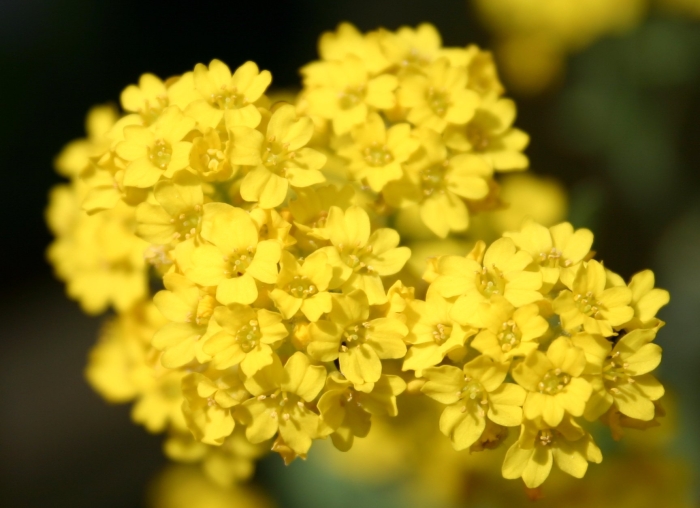Basket Of Gold
(Aurinia saxatilis)
Basket Of Gold (Aurinia saxatilis)
/
/

FoeNyx
CC BY-SA 3.0
Image By:
FoeNyx
Recorded By:
Copyright:
CC BY-SA 3.0
Copyright Notice:
Photo by: FoeNyx | License Type: CC BY-SA 3.0 | License URL: http://creativecommons.org/licenses/by-sa/3.0/ | Uploader: FoeNyx | Publisher: Wikimedia Commons | Title: Alyssum_saxatile.jpg | Notes: ;Name:Azolla caroliniana ;Family:Azollaceae Image no. 2 Permission granted to use under GFDL by Kurt Stueber Source: [http://www.biolib.de www.biolib.de] {{GFDL}} |










































































Estimated Native Range
Summary
Aurinia saxatilis, commonly known as Basket Of Gold, is an evergreen perennial subshrub native to the rocky, mountainous regions of Central and Eastern Europe. It typically grows from 4 to 12 inches high and forms a dense, mounded clump up to 16-20 inches across. The species is characterized by its clear yellow flowers that bloom from mid-to-late spring, creating a vibrant display that completely covers the plant and obscures the foliage. The flowers provide a valuable source of nectar and pollen for bees and other pollinating insects.
Basket Of Gold is highly regarded for its drought tolerance and ability to thrive in poor soils, making it an excellent choice for rock gardens, dry slopes, and garden bed edging. It is also well-suited for use in troughs and as an edging for large pots. While it is a perennial, some gardeners use it for annual spring displays due to its striking floral show. Aurinia saxatilis prefers full sun and well-drained soil with a composition of chalk, sand, or grit. It is adaptable and can survive in a range of soil types, as long as they are not overly rich. The plant should be spaced about 4 inches apart to allow for proper growth. It is generally pest-free but requires good drainage to prevent root rot, especially in pot-grown specimens. Overwatering can be detrimental. Aurinia saxatilis has earned the Royal Horticultural Society’s Award of Garden Merit, highlighting its value in cultivation. It can be propagated by seed in the fall or by tip cuttings in late spring and early summer. However, it is potentially invasive in some regions outside its native range, so gardeners should check local guidelines before planting.CC BY-SA 4.0
Basket Of Gold is highly regarded for its drought tolerance and ability to thrive in poor soils, making it an excellent choice for rock gardens, dry slopes, and garden bed edging. It is also well-suited for use in troughs and as an edging for large pots. While it is a perennial, some gardeners use it for annual spring displays due to its striking floral show. Aurinia saxatilis prefers full sun and well-drained soil with a composition of chalk, sand, or grit. It is adaptable and can survive in a range of soil types, as long as they are not overly rich. The plant should be spaced about 4 inches apart to allow for proper growth. It is generally pest-free but requires good drainage to prevent root rot, especially in pot-grown specimens. Overwatering can be detrimental. Aurinia saxatilis has earned the Royal Horticultural Society’s Award of Garden Merit, highlighting its value in cultivation. It can be propagated by seed in the fall or by tip cuttings in late spring and early summer. However, it is potentially invasive in some regions outside its native range, so gardeners should check local guidelines before planting.CC BY-SA 4.0
Plant Description
- Plant Type: Subshrub, Herb
- Height: 0.5-1 feet
- Width: 1-1.5 feet
- Growth Rate: Moderate
- Flower Color: Yellow
- Flowering Season: Spring
- Leaf Retention: Evergreen
Growth Requirements
- Sun: Full Sun
- Water: Low
- Drainage: Medium, Fast
Common Uses
Bank Stabilization, Bee Garden, Border Plant, Butterfly Garden, Deer Resistant, Drought Tolerant, Fire Resistant, Groundcover, Low Maintenance, Rock Garden, Showy Flowers, Street Planting
Natural Habitat
Native to rocky, mountainous regions of Central and Eastern Europe
Other Names
Common Names: Basket-Of-Gold, Golden-Tuft Alyssum, Golden Alison, Golden-Tuft Madwort, Rock Madwort, Gold-Dust, Felsen-Steinkraut, Praktstenört
Scientific Names: , Aurinia saxatilis, Alyssum saxatile, Alyssum saxatilis, Alyssum orientale, Alyssum arduinii, Alyssum saxatile subsp. megalocarpum, Aurinia orientalis, Alyssum saxatile var. orientale, Alyssum saxatile var. compactum
GBIF Accepted Name: Aurinia saxatilis (L.) Desv.